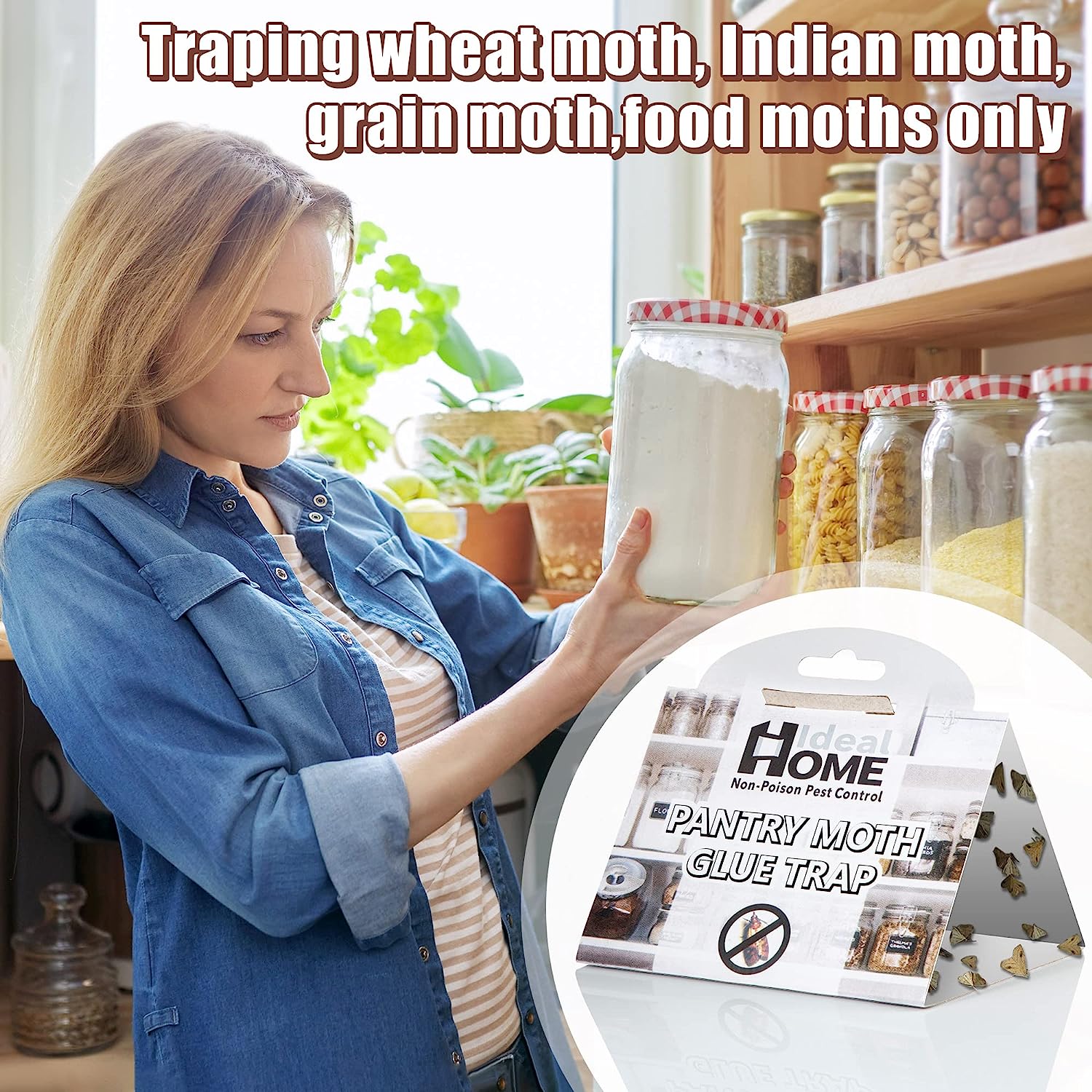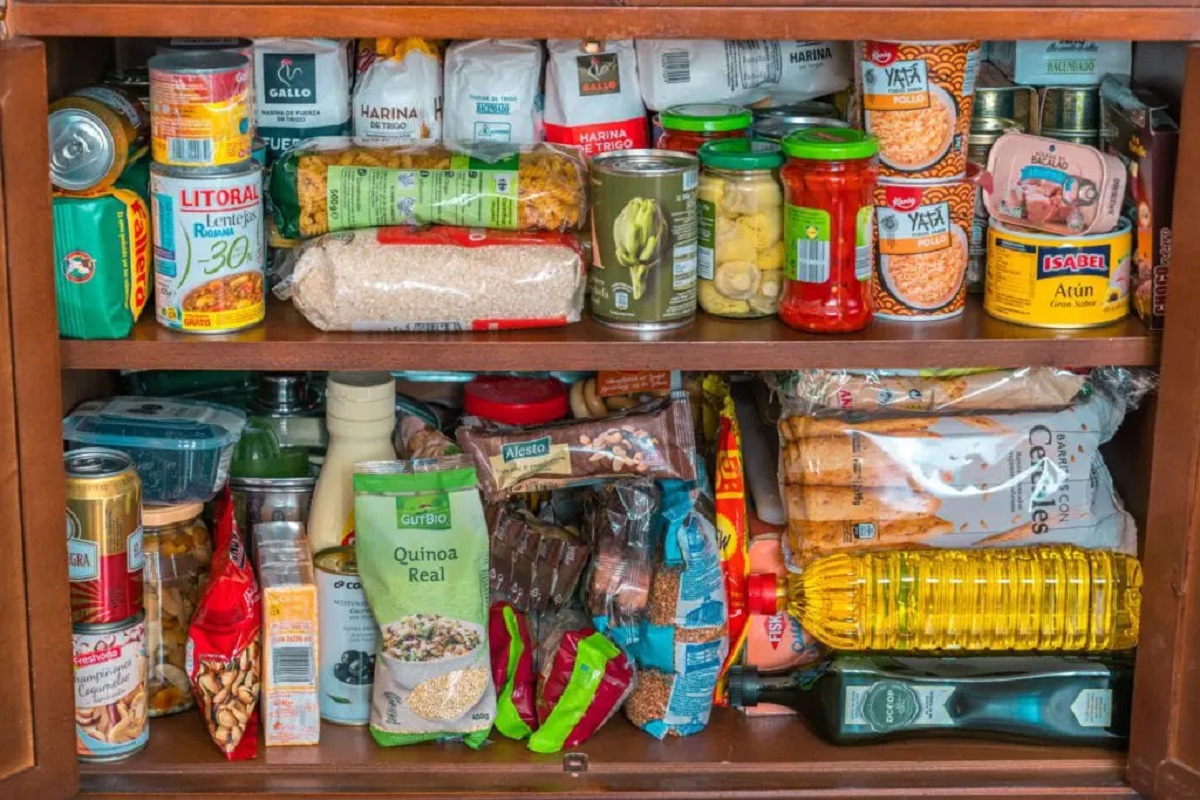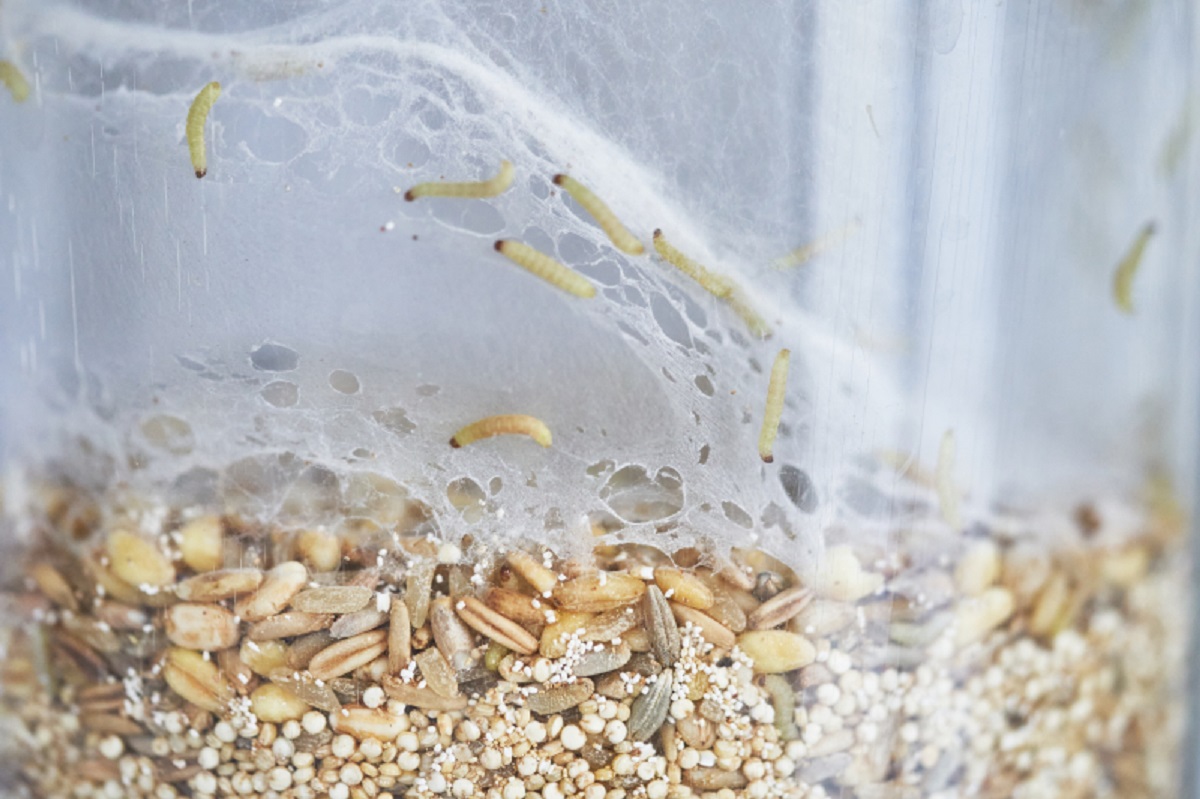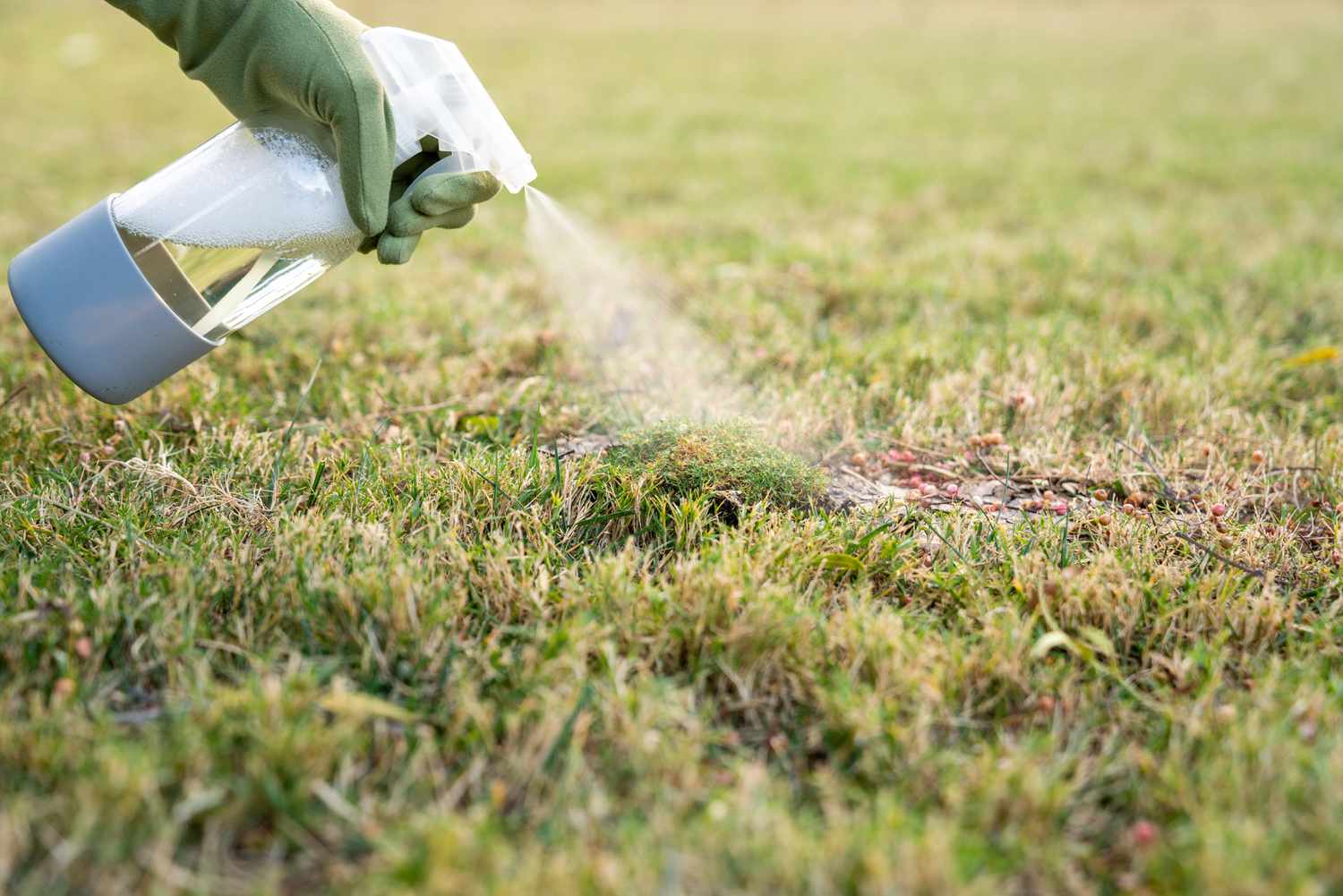

Articles
Pantry Moth How To Get Rid Of
Modified: October 20, 2024
Learn effective methods to get rid of pantry moths and prevent infestations in your pantry storage. Protect your food and keep your pantry clean and pest-free with our expert tips.
(Many of the links in this article redirect to a specific reviewed product. Your purchase of these products through affiliate links helps to generate commission for Storables.com, at no extra cost. Learn more)
Introduction
Pantry moths, also known as Indian meal moths or flour moths, can be a frustrating nuisance in any kitchen. These small pests have a knack for invading your pantry and feasting on your stored food products, leaving behind a trail of damage and unpleasantness. Thankfully, with the right knowledge and preventative measures, you can effectively get rid of pantry moths and keep your kitchen pest-free.
Identification is the first step in combating pantry moth infestations. Adult pantry moths are usually about 1/2 inch in length, with a wingspan of 3/4 to 1 inch. They can vary in color from dull gray to coppery brown. One of the telltale signs of their presence is the presence of small, white larvae or webbing in your food containers or pantry shelves.
Prevention is key when it comes to avoiding pantry moth infestations. Start by regularly cleaning your pantry and food storage areas, removing any spilled or expired food products. Make sure to check the packaging of any new items before bringing them into your pantry, as pantry moths can hitch a ride on infested products. Additionally, keep your pantry well-organized, storing dried goods such as grains, cereals, and nuts in sealed, airtight containers to prevent pantry moths from accessing them.
Regular inspection and cleaning of your pantry can help you catch a pantry moth infestation before it gets out of hand. Remove all items from your pantry shelves, taking care to check for any signs of pantry moths or larvae. Vacuum the shelves thoroughly, paying special attention to cracks and crevices where pantry moths can hide. Wipe down the shelves with a solution of water and vinegar to eliminate any remaining traces of infestation.
Proper food storage is crucial in preventing pantry moth infestations. Invest in high-quality, airtight containers for storing your dried goods. Be sure to transfer any store-bought items into these containers to avoid bringing any pantry moth eggs or larvae into your pantry. If possible, freeze newly purchased items for a few days before placing them in your pantry to kill any potential pantry moths or eggs.
Key Takeaways:
- Don’t let pantry moths take over! Regular cleaning, proper food storage, and natural remedies can help prevent and eliminate infestations, keeping your pantry pest-free and your food fresh.
- Stay vigilant and proactive. Identify pantry moths early, implement prevention measures, and consider natural or chemical remedies when necessary. With consistent care, you can reclaim control of your pantry and keep pests at bay.
Identification of Pantry Moths
Properly identifying pantry moths is essential in order to effectively combat and prevent infestations. Pantry moths, also known as Indian meal moths or flour moths, are small insects that commonly infest kitchen pantries and food storage areas. By understanding their appearance and behavior, you can take the necessary steps to identify and eliminate these unwanted pests.
Adult pantry moths typically measure around 1/2 inch in length, with a wingspan ranging from 3/4 to 1 inch. They have narrow, elongated wings that are generally gray in color, although they can also appear coppery brown. These moths are active flyers and are often seen fluttering around the kitchen and pantry area.
One of the key indicators of a pantry moth infestation is the presence of small white larvae or webbing in your food containers or pantry shelves. The larvae of pantry moths are small, worm-like creatures that feed on a variety of stored food products, including grains, cereals, nuts, seeds, and dried fruits. They create silk-like webbing that can often be found around infested items.
A clear sign of pantry moth activity is the discovery of small, rice-like pods scattered throughout your pantry. These are actually the eggs of the pantry moths, which the adult moths lay on or near the infested food items. If you notice these little pods in your pantry, it’s a strong indication that you have a pantry moth problem.
It’s important to note that pantry moths can easily infest packaged food products, even if they appear to be sealed or unopened. They have the ability to chew through paper, cardboard, and thin plastic, allowing them to access and infest stored food items. Therefore, always inspect the packaging of new food purchases before placing them in your pantry.
Keep in mind that pantry moths are not attracted to dirty or unsanitary environments. They are drawn to pantry areas primarily because of the food sources available to them. Therefore, even the cleanest kitchens can still experience a pantry moth infestation if proper preventative measures are not taken.
In summary, pantry moths are small insects with elongated wings and a wingspan of 3/4 to 1 inch. Adult moths are grey or coppery brown in color and can be seen flying around the kitchen and pantry area. The presence of small white larvae and webbing, as well as rice-like egg pods, are clear indications of a pantry moth infestation. By recognizing these signs, you can take swift action to eliminate pantry moths from your kitchen and prevent further infestations.
Prevention Measures
Preventing pantry moth infestations is crucial to maintaining a clean and pest-free kitchen. By implementing the following prevention measures, you can significantly reduce the risk of pantry moths invading your pantry and infesting your stored food items.
1. Regularly clean your pantry: Keep your pantry clean and free from food debris. Regularly inspect and clean your pantry shelves, wiping down surfaces with a solution of water and vinegar to remove any potential attractants for pantry moths.
2. Dispose of old and expired food: Pantry moths are often attracted to old or expired food items. Regularly check the expiration dates of your food products and dispose of any that are past their prime. Don’t forget to inspect and clean the area where the expired items were stored.
3. Properly store food: Invest in airtight food storage containers to prevent pantry moths from accessing your dried goods. Transfer bulk food items, such as grains, cereals, and nuts, into sealed containers immediately after purchase to create a barrier against pantry moth infestation.
4. Inspect new food purchases: Before bringing new food items into your pantry, inspect the packaging for any signs of damage or infestation. Pantry moths can hitch a ride on infested products, so it’s crucial to catch them before they have a chance to spread.
5. Freeze infestation-prone items: Items that are more prone to pantry moth infestations, such as grains and flours, can be placed in the freezer for a few days to kill any eggs or larvae that may be present before transferring them to your pantry storage.
6. Maintain cleanliness in surrounding areas: Pantry moths can easily spread from neighboring areas, such as cabinets, drawers, or even pet food storage. Regularly clean and inspect these areas to avoid any potential infestation sources.
7. Monitor and rotate stock: As you use items from your pantry, make a habit of rotating stock to ensure that older items are used first. Be vigilant in inspecting and cleaning the areas where the older items were stored to prevent any potential infestations from spreading.
By incorporating these prevention measures into your regular kitchen maintenance routine, you can significantly reduce the chances of pantry moth infestations. With consistent effort and attention to detail, you can keep your pantry free from these pesky pests and preserve the freshness and quality of your stored food items.
Inspection and Cleaning
Regular inspection and cleaning of your pantry are essential steps in preventing and eliminating pantry moth infestations. By conducting thorough inspections and implementing proper cleaning techniques, you can identify any signs of pantry moths early on and take immediate action to prevent further infestation.
1. Remove all items from your pantry: Start by completely emptying your pantry shelves. Take out all food items, including boxed products, bags, and containers. This will allow you to thoroughly inspect each item for signs of pantry moths or larvae.
2. Inspect and discard infested items: Carefully examine each food item for any indications of pantry moth activity. Look for webbing, larvae, eggs, or any signs of damage. Discard any infested items in sealed plastic bags and dispose of them properly to prevent reinfestation.
3. Vacuum the pantry shelves: Use a vacuum cleaner with a narrow attachment to vacuum all the corners, cracks, and crevices of your pantry shelves. Pay extra attention to any remaining food particles or webbing that may be hiding in hard-to-reach areas. Dispose of the vacuum bag or empty the canister outside to prevent pantry moths from reinfesting your home.
4. Wipe down the shelves: After vacuuming, wipe down the shelves with warm water and a mild detergent. This will help remove any remaining residue and eliminate any potential attractants that could draw pantry moths back to your pantry.
5. Inspect the pantry walls and ceiling: Pantry moths can sometimes find their way onto the walls and ceiling of your pantry. Inspect these surfaces for any signs of webbing or cocoons. Use a damp cloth to wipe down these areas and remove any debris or eggs that may be present.
6. Clean food containers and sealing jars: Wash all airtight containers, jars, and lids with warm water and soap to ensure they are free from any potential pantry moth eggs or larvae. Make sure to dry them thoroughly before refilling with fresh food items.
7. Return cleaned and uninfested items: Once your pantry shelves have been thoroughly cleaned and inspected, you can start returning the cleaned and uninfested food items to their respective places. Make sure to organize them properly and place them in sealed containers to prevent future infestations.
8. Monitor regularly and maintain cleanliness: After conducting a deep clean of your pantry, it’s important to remain vigilant and monitor the area regularly. Keep an eye out for any signs of pantry moths and take swift action at the first indication of new infestation.
By incorporating regular inspection and cleaning into your pantry maintenance routine, you will create a hostile environment for pantry moths and significantly reduce the risk of future infestations. Stay proactive and maintain cleanliness in your pantry to keep these unwanted pests at bay.
Proper Food Storage
Proper food storage is essential in preventing pantry moth infestations and ensuring the longevity and freshness of your stored food items. By following these guidelines for food storage, you can create a barrier against pantry moths and other pests and maintain a clean and organized pantry.
1. Invest in airtight containers: Purchase high-quality airtight containers for storing your dried food items. These containers help keep pantry moths out and prevent them from accessing your stored food. Opt for containers made of sturdy materials such as glass or BPA-free plastic, with tight-fitting lids to ensure a secure seal.
2. Transfer bulk items into sealable containers: When purchasing bulk food items such as grains, flours, cereals, nuts, and dried fruits, it’s important to transfer them into your own sealable containers. This helps prevent the introduction of pantry moths or eggs that may be present in the original packaging.
3. Check packaging before storing: Before placing any new food items in your pantry, carefully inspect the packaging for any signs of damage or infestation. Look for holes, webbing, larvae, or any indication of pantry moth activity. Reject and return any items that show signs of infestation.
4. Store food off the ground: Keep your stored food items elevated off the ground and away from walls. Pantry moths can easily crawl or fly into your pantry from nearby cracks and crevices, so it’s important to create a physical barrier by storing items on shelves or in cabinets.
5. Organize and rotate stock: Arrange your pantry in an organized manner, grouping similar food items together. This makes it easier to monitor and rotate your stock, ensuring that older items are used first. Regularly check expiration dates and use the first-in, first-out (FIFO) method to prevent food items from sitting in your pantry for extended periods.
6. Keep it clean: Regularly clean your food storage containers to remove any residue, crumbs, or food particles that may attract pantry moths. Use warm water and soap to wash the containers, and ensure they are thoroughly dried before refilling them with fresh food items.
7. Avoid cardboard packaging: Pantry moths can easily chew through cardboard packaging, allowing them to access your stored food. Whenever possible, opt for products that come in sealed plastic or glass containers, or transfer the contents into your own airtight containers.
8. Consider using bay leaves or other natural repellents: Place a few bay leaves or other natural repellents, such as cloves or cedar balls, in your food storage areas. Pantry moths are known to dislike the strong scent of these items, which can help deter them from infesting your pantry.
By following these proper food storage practices, you can create an environment in your pantry that is less attractive to pantry moths and other pests. Take the time to organize, clean, and monitor your food storage regularly to maintain a pest-free pantry and preserve the quality of your stored food items.
To get rid of pantry moths, start by removing all infested food items and thoroughly cleaning the pantry. Use pheromone traps to catch adult moths and consider freezing susceptible items for a few days to kill any eggs or larvae. Keep the pantry clean and store food in airtight containers to prevent future infestations.
Natural Remedies for Pantry Moth Control
Dealing with a pantry moth infestation can be frustrating, but you can tackle the problem using natural methods that are safe and effective. By incorporating these natural remedies into your pantry moth control strategy, you can eliminate the pests and prevent them from returning.
1. Bay leaves: Place a few bay leaves in your pantry and storage containers. Pantry moths are repelled by the strong scent of bay leaves, making them less likely to infest your stored food items. Replace the bay leaves every few months to ensure their effectiveness.
2. Vinegar traps: Create vinegar traps by filling small containers with equal parts vinegar and water. Add a few drops of dish soap to break the surface tension. Place these traps near your pantry shelves to attract and drown adult pantry moths. Empty and refill the traps regularly.
3. Cloves and cinnamon sticks: Pantry moths are deterred by the strong scent of cloves and cinnamon sticks. Place these natural repellents in your pantry, or tie them in small cheesecloth bags and hang them near your stored food items. Replace them periodically to maintain their effectiveness.
4. Freezing: If you suspect that a food item in your pantry is infested with pantry moth eggs or larvae, place it in the freezer for several days. The extreme cold will kill the eggs and larvae, preventing further infestation. Once frozen, discard the item in a sealed plastic bag.
5. Vacuuming: Regularly vacuum your pantry shelves, cracks, and crevices to remove any pantry moth eggs, larvae, or webbing. Dispose of the vacuum bag or empty the canister outside to prevent reinfestation. This can help eliminate existing pests and prevent their propagation.
6. Proper ventilation: Ensure that your pantry is well-ventilated to deter pantry moths. Good air circulation helps keep the area dry, reducing the conditions that pantry moths are attracted to. Use fans or open windows to improve airflow in and around your pantry.
7. Sift flour and grains: Before transferring bulk flour, cereal, or grain products into your pantry, sift them through a fine mesh sieve. This will help remove any potential pantry moth eggs or larvae that may have been present in the packaging or during storage.
8. Regular maintenance: Implement regular cleaning and organization routines in your pantry. Remove and inspect items periodically, checking for signs of infestation. Wipe down shelves, vacuum corners, and keep your pantry free of spilled or expired food items.
Remember, natural remedies may require consistency and patience to effectively control pantry moth infestations. By combining these natural methods with proper storage practices, you can eliminate pantry moths from your kitchen and maintain a pest-free pantry.
Chemical Treatments for Pantry Moth Infestation
When natural remedies and preventative measures fail to control a severe pantry moth infestation, you may need to turn to chemical treatments to effectively eliminate the pests. It’s essential to use these treatments safely and according to the manufacturer’s instructions to minimize any potential risks. Here are some commonly used chemical treatments for pantry moth infestations:
1. Insecticide sprays: There are insecticide sprays specifically formulated for pantry moth control. Look for a product that is labeled for use against pantry moths and follow the instructions carefully. Apply the spray to cracks, crevices, and infested areas in your pantry, targeting the adult moths directly.
2. Residual insecticide powder: Residual insecticide powders can be applied to cracks, crevices, and other hiding spots in your pantry. These powders are designed to remain active for an extended period, offering long-lasting protection against pantry moth infestations. Ensure the powdered areas are kept away from food and inaccessible to children or pets.
3. Pheromone traps: Pheromone traps can be effective in capturing adult male pantry moths and preventing them from mating. These traps use synthetic pheromones to attract the male moths, trapping them on sticky surfaces. Place the traps strategically in your pantry, following the manufacturer’s instructions for optimal results.
4. Aerosol insecticides: Aerosol insecticides can be used to treat infested areas directly. Spray the aerosol into cracks, crevices, and other potential hiding places where pantry moths may be present. It’s important to read and follow the instructions provided by the manufacturer to ensure safe and effective application.
5. Foggers or fumigators: Foggers or fumigators are designed to release an insecticidal mist or smoke, evenly distributing the treatment throughout the infested area. Make sure to remove all food items from your pantry and carefully follow the instructions on the product to ensure proper usage. Once the treatment is complete, thoroughly clean and ventilate the area before returning food items to the pantry.
It’s important to note that chemical treatments should be used as a last resort and should always be handled with caution. Follow all safety precautions outlined on the product labels, and consider consulting a professional pest control service for severe or persistent infestations. Keep in mind that chemical treatments can leave residue on surfaces, so be sure to thoroughly clean and sanitize your pantry before restocking.
Remember, prevention is key in avoiding pantry moth infestations, and regular inspection, cleaning, and proper food storage techniques can help minimize the need for chemical treatments. However, if you find yourself facing a severe pantry moth infestation, chemical treatments can provide a targeted approach to eliminate the pests and restore order to your pantry.
Additional Tips for Getting Rid of Pantry Moths
Dealing with a pantry moth infestation can be challenging, but with the following additional tips, you can enhance your efforts to eliminate these pests and prevent them from returning:
1. Dispose of infested items: If you discover signs of pantry moth infestation in any of your food items, discard them immediately in sealed plastic bags. This prevents the infestation from spreading to other items in your pantry.
2. Deep-clean surrounding areas: Pantry moths can hide in cracks, crevices, and other areas near your pantry. Thoroughly clean and vacuum these areas, including cabinets, drawers, and nearby shelves, to remove any eggs, larvae, or moths that may be lurking.
3. Use light traps: Adult pantry moths are attracted to light. Placing a light trap near your pantry can help capture and eliminate these pests. Opt for a commercially available light trap or make your own by placing a bright light source above a container filled with soapy water.
4. Consider professional assistance: If your pantry moth infestation persists despite your efforts, it may be beneficial to seek professional pest control services. Pest control professionals have the expertise and resources to effectively eradicate pantry moths from your home.
5. Store susceptible items in the refrigerator: If you frequently encounter pantry moth infestations in specific food items, such as pet food or birdseed, consider storing these items in the refrigerator. The cool temperature will deter pantry moths from infesting them.
6. Maintain a tidy kitchen: Regularly clean your kitchen, wiping down countertops, sweeping the floor, and removing any food debris. Keeping your kitchen clean and free from crumbs or spills makes it less attractive to pantry moths and other pests.
7. Monitor new purchases: Always inspect new food items before bringing them into your pantry. Check the packaging for any signs of damage or infestation, and transfer them to sealed containers before storing them.
8. Practice vigilance: Even after successfully getting rid of pantry moths, it’s crucial to remain watchful. Conduct regular inspections of your pantry, checking for any signs of reinfestation. By catching any issues early on, you can quickly implement necessary measures to prevent a full-blown infestation.
Remember, the key to getting rid of pantry moths is a combination of cleanliness, proper food storage, and consistent monitoring. By implementing these additional tips and maintaining good pantry hygiene, you can ensure a pest-free kitchen and enjoy preserved, uncontaminated food items.
Conclusion
Pantry moths can be a persistent nuisance in any kitchen, but with the right knowledge and proactive measures, you can effectively eliminate these pests and keep them from returning. By implementing proper identification techniques, prevention measures, inspection and cleaning routines, and utilizing natural or chemical remedies when necessary, you can regain control of your pantry and protect your stored food items.
Identifying pantry moths and recognizing the signs of infestation is vital in addressing the problem early on. Take the time to familiarize yourself with the appearance of adult moths, larvae, and their telltale webbing or eggs. Early detection sets the stage for swift and effective action.
Prevention is a key pillar in keeping your pantry moth-free. Regularly clean your pantry, dispose of expired food items, invest in airtight containers, and remain vigilant when inspecting new purchases. By implementing these preventive measures, you create an environment that is less attractive to pantry moths and reduce the risk of infestations.
Regular inspection and cleaning is essential in maintaining a pest-free pantry. Empty your pantry shelves, vacuum crevices, wipe down surfaces, and discard any infested items. This practice helps remove existing pantry moths, larvae, and eggs, while also promoting cleanliness and organization in your pantry.
When it comes to pantry moth control, there are both natural and chemical remedies available. Natural solutions like bay leaves, vinegar traps, and proper ventilation can help deter pantry moths, while chemical treatments such as insecticide sprays or pheromone traps may be necessary for severe infestations. Always follow instructions carefully and prioritize safety when using chemical treatments.
Additional tips, including proper disposal of infested items, deep-cleaning surrounding areas, using light traps, and considering professional assistance, can further enhance your efforts to eliminate pantry moths and maintain a pest-free kitchen.
In conclusion, by combining proper identification, prevention, inspection, cleaning, and the utilization of natural or chemical remedies, you can regain control of your pantry and prevent future pantry moth infestations. Stay proactive, maintain good hygiene practices, and monitor your pantry regularly to keep these unwanted pests at bay. With proper care and attention, you can enjoy a clean and pest-free kitchen, ensuring the freshness and quality of your stored food items.
Frequently Asked Questions about Pantry Moth How To Get Rid Of
Was this page helpful?
At Storables.com, we guarantee accurate and reliable information. Our content, validated by Expert Board Contributors, is crafted following stringent Editorial Policies. We're committed to providing you with well-researched, expert-backed insights for all your informational needs.















0 thoughts on “Pantry Moth How To Get Rid Of”